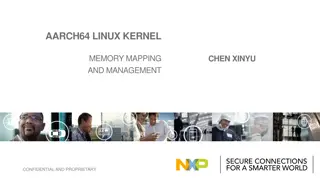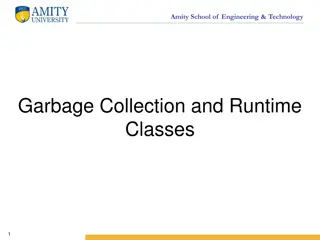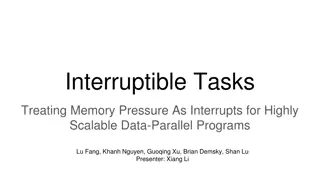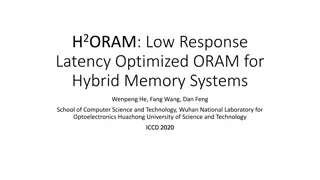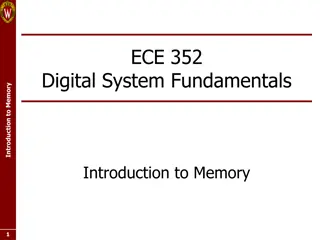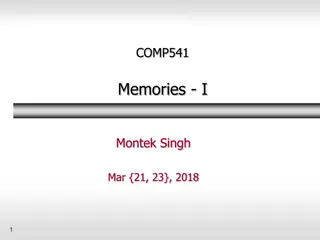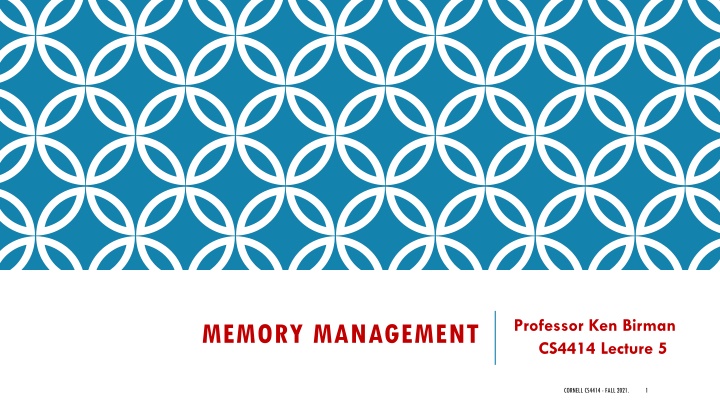
Memory Management in Linux Processes - CS4414 Lecture Highlights
Explore the concepts of memory management in Linux processes as discussed in a CS4414 lecture. Topics include address space organization, memory segmentation, and the role of pages and segments in managing memory efficiently.
Download Presentation

Please find below an Image/Link to download the presentation.
The content on the website is provided AS IS for your information and personal use only. It may not be sold, licensed, or shared on other websites without obtaining consent from the author. If you encounter any issues during the download, it is possible that the publisher has removed the file from their server.
You are allowed to download the files provided on this website for personal or commercial use, subject to the condition that they are used lawfully. All files are the property of their respective owners.
The content on the website is provided AS IS for your information and personal use only. It may not be sold, licensed, or shared on other websites without obtaining consent from the author.
E N D
Presentation Transcript
Professor Ken Birman CS4414 Lecture 5 MEMORY MANAGEMENT CORNELL CS4414 - FALL 2021. 1
IDEA MAP FOR TODAY Address space for a Linux process: many kinds of segments Global objects live in data segments Understanding where an object resides is very important in modern systems. In C++, you can t write correct code unless you master this topic Inline objects live on the stack If time permits: How malloc manages the heap Dynamically created objects live in the heap CORNELL CS4414 - FALL 2021. 2
WHAT HAPPENS WHEN YOU RUN A COMMAND? Linux really has three concepts of what a command can be 1. The bash shell has some built-in commands 2. You can take any sequence of commands and put them in a file, change its mode to executable , and then the file name behaves like a Linux command. You can even pass it arguments, include loops, etc! 3. A compiled program, perhaps starting with C++ source CORNELL CS4414 - FALL 2021. 3
WHAT HAPPENS WHEN YOU RUN A PROGRAM? Bash sees that you are trying to execute a program it finds the file and checks, and learns that it is an executable (and remembers this, for quicker future responses) Bash uses Linux to prepare an address space and then load and execute the program in the new address space. This is done with the fork and exec systems calls. (Both have several variants). We ll discuss later details not important today CORNELL CS4414 - FALL 2021. 4
A page page is a 4K block of memory ADDRESS SPACE? 0 Every program runs in an isolated address context. Within it, the addresses your program sees are virtual . They don t match directly to addresses in physical memory. A page table managed by Linux maps virtual to physical, at a granularity that would usually be 4k (4096) bytes per page. CORNELL CS4414 - FALL 2021. 5
PAGES ARE GROUPED INTO SEGMENTS Rather than just treating memory as one range of pages from address 0 to whatever the current size needed might be, Linux is segmented. There are often gaps between them. Definition: A segment is just a range of virtual memory with some base address, and some total size, and access rules. One segment might be as small as a single page, or could be huge with many pages. We don t normally worry about page boundaries CORNELL CS4414 - FALL 2021. 6
A FEW SEGMENT TYPES LINUX SUPPORTS Code: This kind of segment holds compiled machine instructions Data: Uses for constants and initialized global objects Stack: A stack segment is used for memory needed to call methods, or for inline variables (I ll show you an example). Heap: A heap segment is used for dynamically allocated memory that will be used for longer periods (again, I ll show you) Mapped files: The file can be accessed as a byte[] vector! CORNELL CS4414 - FALL 2021. 7
GAPS The address space will often have holes in it. These are ranges of memory that don t correspond to any allocated page. If you try and access those regions, you ll get a segmentation fault and your process will crash. CORNELL CS4414 - FALL 2021. 8
STACKS, HEAPS Our programs often need to dynamically allocate memory to hold new objects. Later they might free that memory. The stack and the heap are two resources for doing this. CORNELL CS4414 - FALL 2021. 9
STACKS VERSUS HEAPS A stack is a managed region of memory that has a concept of a stack pointer. You push objects on the stack, and the stack pointer changes (the value gets smaller) by the size of the object later you pop the object and the stack pointer gets larger. Stack segment encloses the entire stack. But not all of it is in use pop 91 Bottom 77 Push 77 Push 91 Bottom 77 91 Bottom Bottom 77 Stack pointer points to the top element In Linux, stacks always grow from big addresses down towards small addresses CORNELL CS4414 - FALL 2021. 10
HEAPS A heap is a memory segment accesed via malloc/free NUMA heaps: Linux maintains one heap region (pool) per DRAM module, tries put your new memory close to your thread. CORNELL CS4414 - FALL 2021. 11
INITIALIZATION In C++ we normally use objects with constructors that initialize the fields to desired values. For this reason, new memory won t be automatically zeroed: you ll put the values you want into that memory. Data segment is initially zero, but that is really a special case. Of course you can always zero a memory region by hand CORNELL CS4414 - FALL 2021. 12
YOUR C++ PROGRAM CONTROLS WHERE THE VARIABLES IT USES WILL LIVE int cat_count = 0; // Global: Lives in a data segment class Cat { // Definition: Used only by g++ public: int cat_id; // The object will have space for a 32-bit int std::string name; // and for a string object Cat(std::string given_name) { // Constructor to initialize a new Cat instance name = given_name; cat_id = cat_count++; } } CORNELL CS4414 - FALL 2021. 13
YOUR C++ PROGRAM CONTROLS WHERE THE VARIABLES IT USES WILL LIVE external Cat fluffy; // Global, initialized elsewhere Cat irma( Irma ); // Global, initialized here. Object will live in data segment int main(int argc, char** argv) { Cat streetcat( Grizabella ); // Stack, created now, actually on the stack. // The object will be deallocated when scope exits Cat *catptr = newCat( Mistophelles ); // Heap! Remains allocated until you call delete } Scope: The execution block in which the variable is accessible CORNELL CS4414 - FALL 2021. 14
PUZZLE: WHERE IS THE BYTE[] FOR STRINGS? We used std::string to hold the cat names. Where is the memory? Internally, a std::string includes a pointer to a character array: a byte vector, terminated with a null byte ( \0 ). In the heap! std::string makes a copy using malloc and memcpy If you copy a std::string, a heap char string is made by the copy constructor But where is the string itself, in memory? CORNELL CS4414 - FALL 2021. 15
MALLOC AND FREE You don t see it, but internally, C++ implements new using malloc, and delete using free. These are library methods built in C that manage pools of memory: one per DRAM module on your NUMA computer. Notice that new and delete are not needed for global or stack- allocated objects. Question: why not? CORNELL CS4414 - FALL 2021. 16
GLOBAL AND STACK ALLOCATION A global object will be assigned space in the data segment. The compiler handles this, and runs the constructor either at compile time, or (if the constructor uses things that aren t constants), when the program starts execution. A stack allocated object will be assigned a chunk of space on the stack when the line of code executes to create the object. The constructor runs when this occurs. CORNELL CS4414 - FALL 2021. 17
THE STACK IS ALSO USED FOR METHOD CALLS Roles of the stack: Hold return PC Hold stack-allocated data Hold values of registers that will temporarily be used but then restored to whatever was previously in them Hold method arguments that don t fit into registers Hold results from a method, if the result is large CORNELL CS4414 - FALL 2021. 18
CALLING A METHOD C++ generates code to put arguments into registers, or onto the stack. It has its own rules to decide which case applies. The Intel hardware automatically pushes the caller s PC to the stack. Later it uses this to return to where the call was done. On return, Intel pops the PC from the stack. C++ pops anything it pushed, and we are back to the state from before the call. CORNELL CS4414 - FALL 2021. 19
C++ NOTATIONS FOR ACCESSING THINGS C++ has a concept of a namespace used to understand the variable you are referencing. For example, std::queue is a reference to a class called queue that was defined in the standard library (std:: means standard ) Pronunciation hint: Ken just says st-it-id for std:: CORNELL CS4414 - FALL 2021. 20
VARIABLES VERSUS POINTERS Suppose some variable cat is in the current scope, and we access it. Some examples: auto cat2 = cat; // Constructs a copy cid = cat.cat_id; // References a member auto cptr = &cat; // Creates a pointer to cat CORNELL CS4414 - FALL 2021. 21
POINTER: A VARIABLE HOLDING AN ADDRESS A pointer variable has a 64-bit number in it: a memory location. You need to make sure it points to a sensible place! But then can access members, like cptr cat_id. (*cptr).cat_id is equivalent: (*cptr) is the cat object that cptr points to. CORNELL CS4414 - FALL 2021. 22
ACCESS BY REFERENCE Often you see methods with types like this: int sum(const int& a, const int& b) { return a+b; } The & a will be a reference to the argument Thus, a acts like a second name an alias for the argument supplied by the caller. The by reference notation, &, can only be used if the passed argument is a variable it could appear on the left side of an = CORNELL CS4414 - FALL 2021. 23
C++ ALLOWS REFERENCE RETURN VALUES For example, you can write a method that returns a reference to some object that is in an array, or even one it just created! But beware . A reference or pointer to an object on the stack will be unsafe if that stack scope terminates! And a reference or pointer into the heap is only valid as long as you haven t deleted the object in the heap that it points to! CORNELL CS4414 - FALL 2021. 24
ARRAYS USE A FORM OF REFERENCES C++ has two concepts of array indexing. If myvec is of type int[10], then myvec[k] is the k th element. Note that C++ doesn t check for illegal index values! Overloaded operators become method calls, to methods defined by the class But you can also overload the [ ] operator for classes of your own. For example, cat.litter[k] could be the k th kitten in a list. CORNELL CS4414 - FALL 2021. 25
SHARED_PTR When working with pointers, people often call malloc, but then forget to call free. C++ isn t garbage collected, so the malloc ed objects will linger for as long as the program runs. This is called a memory leak. The heap segment grows and grows. Eventually a process can run out of space and crash. CORNELL CS4414 - FALL 2021. 26
SHARED_PTR Professional C++ developers prefer not to use pointers directly. We wrap them in a shared_ptr template. With a shared_ptr, when the object has no more references to it, the delete method is called automatically. This adds garbage collection to C++, in a controlled form! https://docs.microsoft.com/en-us/cpp/cpp/how-to-create-and-use-shared-ptr-instances?view=vs-2019 CORNELL CS4414 - FALL 2021. 27
SHARED_PTR Example: auto my_ptr = new shared_ptr<foo>(constructor args); auto ptr_2 = my_ptr; // Auto-increments reference count! When a shared_ptr goes out of scope, the reference count is decremented automatically. Delete is called if it reaches 0. CORNELL CS4414 - FALL 2021. 28
USE A SHARED_PTR LIKE ANY POINTER Suppose foo has a field name . With a foo* pt, you write pt name; pt holds an address. With a shared_ptr<foo> pt, you use the identical notation! The shared pointer object holds the address of the foo object. By overloading the operator, the shared_ptr mimics a pointer! CORNELL CS4414 - FALL 2021. 29
MEMORY LEAK Suppose that your program includes code that might be causing a memory leak. The memory is consumed, but never released, so the heap gets larger and larger. You ll see this in top and your program will slow down when the memory region gets really large. Best tool for finding leaks: valgrind CORNELL CS4414 - FALL 2021. 30
MALLOC IS INEXPENSIVE BUT NOT FREE It maintains a big pool of memory and uses various techniques to try and keep memory compact. Fragmentation. Refers to an accumulation of tiny chunks of memory that can t be reused because they are too small for most purposes. Compaction. Free looks for chances to combine small chunks into larger ones, which are more likely to be useful in future mallocs. This is different from garbage collection, which refers to mechanisms that automatically free an object that no longer has any references to it. CORNELL CS4414 - FALL 2021. 31
MALLOC/FREE IMPLEMENT DYNAMIC MEMORY MANAGEMENT FOR C++ One worry: malloc is not infinitely fast and can be a bottleneck. Many performance-intensive applications maintain freelists: Only use malloc if the free list is empty. This reduces the pressure on the malloc/free subsystem. CORNELL CS4414 - FALL 2021. 32
HOW A FREELIST WORKS When you create your class Foo, you also maintain a list of pointers to freed Foo objects: std::list<Foo*> freelist; Suppose fptr points to a Foo (allocated using new): When finished with fptr, put it on the freelist (and don t delete it). The destructor won t run: fptr is still in use. When you need another Foo, check to see if there is a free one on the list. If so, reuse it instead of creating a new object. CORNELL CS4414 - FALL 2021. 33
WHICH SEGMENTS HOLD WHICH KINDS OF MEMORY? Let s tour the computer from the hardware up . The NUMA computer has a big memory region that encompasses all memory on the machine. Any thread with permission can access any part of this memory (local memory is cheapest). There may also be memory regions associated with devices such as computer displays, cameras, etc. CORNELL CS4414 - FALL 2021. 34
VISUALIZING AN ACTIVE PROCESS DLL segment Stack C++ Standard Library Data segment for DLL Code segment DLL segment void main(int argc, char* argv) { . } Linux system calls Data segment Data segment for DLL int my_counter = 0; Thread, has an associated stack Heap segment Mapped File Managed by malloc/free CORNELL CS4414 - FALL 2021. 35
DIFFERENT THREADS IN ONE PROCESS SHARE THE SAME ADDRESS SPACE The memory of a computer is actually linear, although with gaps used in various ways by the hardware and operating system. We think of the address space as if each thread was next to the other threads, but if you look at the addresses each has its own memory segment. Linux manages a mapping from the addresses each process sees to the actual physical memory. Called a page table . CORNELL CS4414 - FALL 2021. 36
VISUALIZING AN ACTIVE PROCESS Stack Stack Stack Shared DLL segment Shared code segment C++ Standard Library void main(int argc, char* argv) { . } Shared Data segment for DLL Shared global data segment Shared DLL segment int my_counter = 0; Linux system calls Threads, each has an associated stack Heap segment Heap segment One heap per RAM pool Managed by malloc/free Shared Data segment for DLL Managed by malloc/free Managed by malloc/free Mapped File CORNELL CS4414 - FALL 2021. 37
DIFFERENT PROCESSES HAVE DISTINCT ADDRESS SPACES Each distinct process has its own address space mapping. Thus an address can mean different things: my 0x10000 might contain code for fast-wc, but your 0x10000 could be part of a data segment. The hardware knows which process is running, so it can use the proper page table mapping to know which memory it wants. CORNELL CS4414 - FALL 2021. 38
MAPPED FILES We will discuss more in a future lecture. But Linux has a system call that will map a file into memory so that the bytes are directly accessible without doing read/write For sharing between processes (particularly helpful across programming languages!). Shared file are limited to one writer. CORNELL CS4414 - FALL 2021. 39
VIRTUAL AND PHYSICAL MEMORY The hardware allows us to page out chunks of memory to a disk. If the process touches such a page, a page fault occurs. Then the kernel loads the missing page and lets the process resume execution. When low on space, this can help but it also can be costly! CORNELL CS4414 - FALL 2021. 40
SOME SEGMENTS ARE SHARED BY MULTIPLE PROCESSES A mapped file appears in memory, like char* array. You can access the bytes directly. Linux picks the base address (hence the same file can easily show up at different places in different processes!) Changes are automatically rewritten back to the disk. Only one process can do updates; others are read only CORNELL CS4414 - FALL 2021. 41
SOME SEGMENTS ARE SHARED BY MULTIPLE PROCESSES Consider the standard C++ library. Lots of programs use it! This segment is read-only, so more than one program can share a single copy. We call it a dynamically linked library or DLL We ll learn how Linux implements DLLs later in the course. CORNELL CS4414 - FALL 2021. 42
HOW SEGMENTS GROW Heaps and stacks are the two kinds of segments that can grow as needed, or shrink. A stack has a limited maximum size, but Linux initially makes it small. As methods call each other and stack space is needed, Linux finds out and quietly grows the top of the stack. This is a case of a handled segmentation fault. If you use up the limit, then you get a stack overflow error, and a crash. CORNELL CS4414 - FALL 2021. 43
HOW SEGMENTS GROW The heap has an initial size, but can be expanded by calling the sbrk Linux system call. Malloc uses this to request extra space. The heap grows at the bottom, towards larger addresses. With NUMA, there is one heap per RAM, and memory is allocated on a RAM close to the thread that called malloc. CORNELL CS4414 - FALL 2021. 44
WHAT IF YOU ACCESS A SEGMENT ILLEGALLY? The most notorious way for a process to crash in Linux is a segmentation fault This means it tried to read from an address that isn t mapped into its address space, or from an unreadable region (or write, or execute). Linux terminates the whole process and might also save a core file for you to study using gdb to understand what crashed. CORNELL CS4414 - FALL 2021. 45
From the textbook, if we have time DEEPER DIVE CORNELL CS4414 - FALL 2021. 46
Carnegie Mellon Mechanisms in Procedures P( ) { y = Q(x); print(y) } Passing control To beginning of procedure code Back to return point Passing data Procedure arguments Return value int Q(int i) { int t = 3*i; int v[10]; return v[t]; } Memory management Allocate during procedure execution Deallocate upon return Mechanisms all implemented with machine instructions x86-64 implementation of a procedure uses only those mechanisms required 47 Bryant and O Hallaron, Computer Systems: A Programmer s Perspective, Third Edition
Carnegie Mellon Mechanisms in Procedures P( ) { y = Q(x); print(y) } Passing control To beginning of procedure code Back to return point Passing data Procedure arguments Return value int Q(int i) { int t = 3*i; int v[10]; return v[t]; } Memory management Allocate during procedure execution Deallocate upon return Mechanisms all implemented with machine instructions x86-64 implementation of a procedure uses only those mechanisms required 48 Bryant and O Hallaron, Computer Systems: A Programmer s Perspective, Third Edition
Carnegie Mellon Mechanisms in Procedures P( ) { y = Q(x); print(y) } Passing control To beginning of procedure code Back to return point Passing data Procedure arguments Return value int Q(int i) { int t = 3*i; int v[10]; return v[t]; } Memory management Allocate during procedure execution Deallocate upon return Mechanisms all implemented with machine instructions x86-64 implementation of a procedure uses only those mechanisms required 49 Bryant and O Hallaron, Computer Systems: A Programmer s Perspective, Third Edition
Carnegie Mellon Mechanisms in Procedures P( ) { y = Q(x); print(y) } Passing control To beginning of procedure code Back to return point Passing data Procedure arguments Return value int Q(int i) { int t = 3*i; int v[10]; return v[t]; } Memory management Allocate during procedure execution Deallocate upon return Mechanisms all implemented with machine instructions x86-64 implementation of a procedure uses only those mechanisms required 50 Bryant and O Hallaron, Computer Systems: A Programmer s Perspective, Third Edition




